Sodden blankets, swollen hands and police sweeps: Surviving on the streets during LA’s historic storm
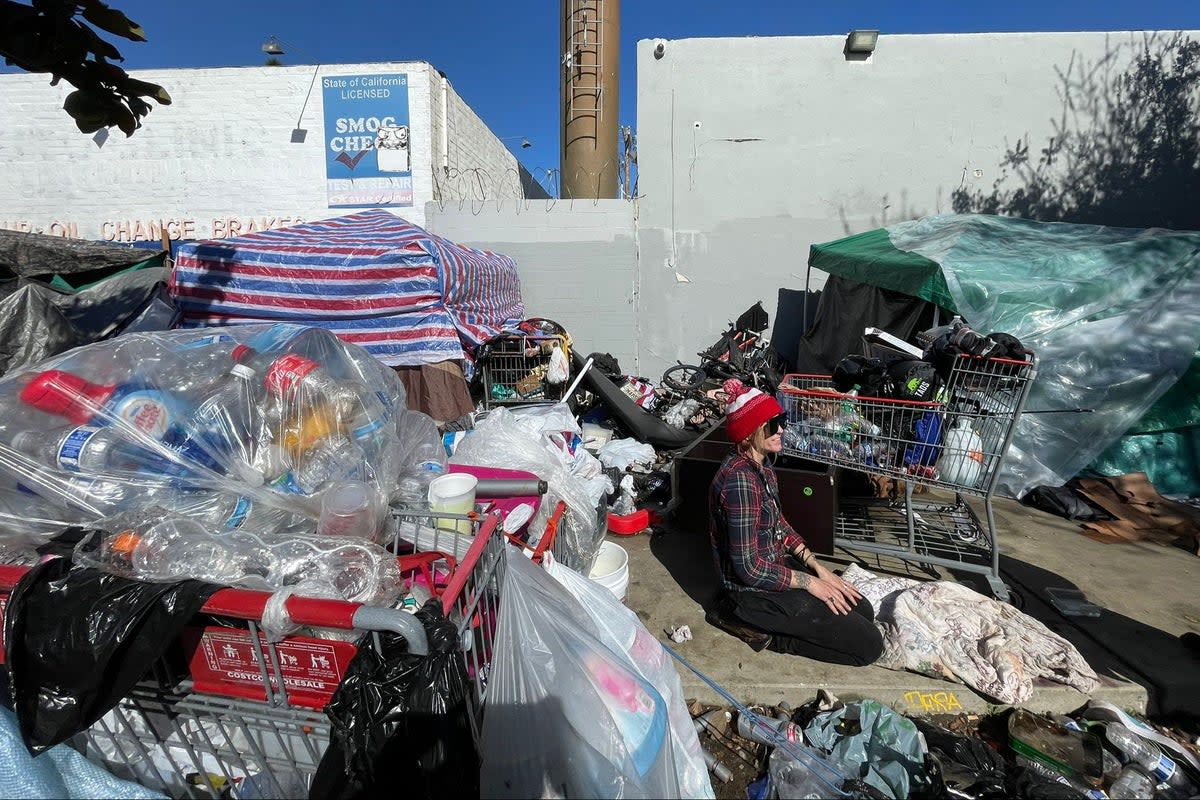
In a small Metrolink car park north of Los Angeles, Carla Orendorff packs up a trolley with plastic storm kits – containing items such as plastic cutlery, sleeping bags and socks – to distribute among those living on the streets on Thursday morning.
Her dog, Lavi, “insisted” on coming with her, she tells The Independent.
Carla is barely out of the parking lot when she spies someone she knows, who waves. “How did you do in the rain?” she asks.
“Horrible,” comes the response, “I was soaking wet and cold as s***”.
Carla is one of several outreach workers for the unhoused community living in Van Nuys, an area in the San Fernando Valley of LA. The informal team – composed of volunteers – often goes out providing supplies bought with their own money to those in need, but operations have been ramped up in recent weeks during the intense storms that have battered the state of California.
For many of LA’s unhoused population, which numbers in the tens of thousands, the impacts were acute and devastating.
As the storm system shifted further south east on Friday and sunny blue skies returned, clean-up operations had begun across the city. It was clear that some had weathered the extreme conditions far better than others.
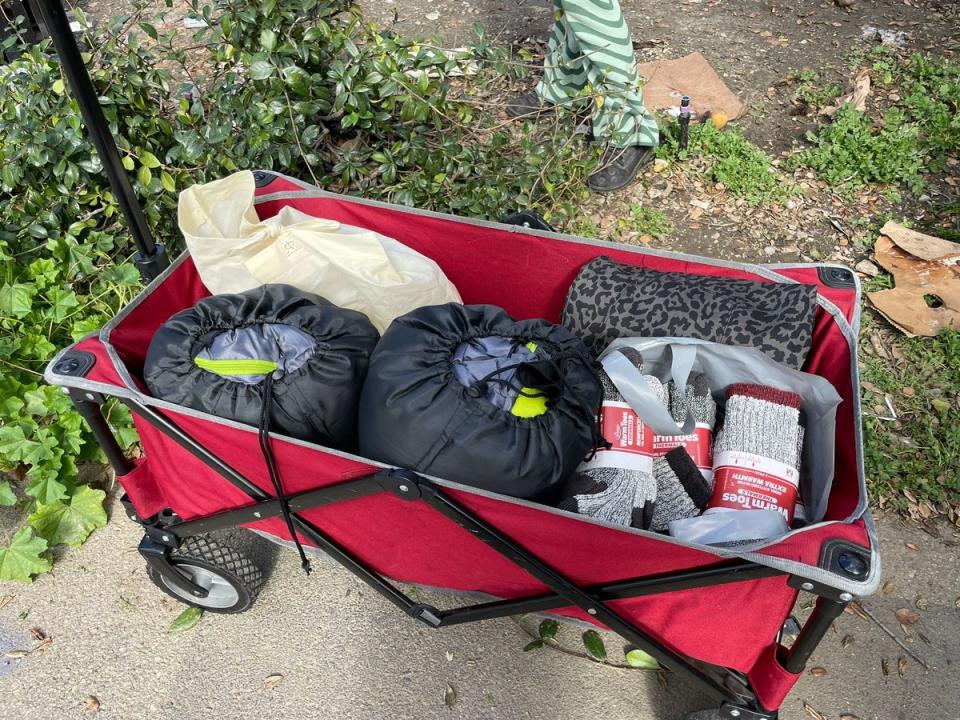
‘Every time the rain came it tore everything down’
The man who flagged Carla down is Nick, 30, who has been on the streets properly for three months but says that he has experienced homelessness on-and-off for about a year. Dressed in a hoodie and thick boots, he graciously accepts a sleeping bag, and describes how the storm impacted him.
“Every time the rain came it tore everything down,” he says. “It was almost as bad as the hurricane [Hilary, in August 2023] but that wasn’t as cold. This was stupid cold.”
He continues: “I was kind of busy trying to keep the inside of my tent up because the wind had broken the sticks. It was like a light drizzle but heavy rain at the same time. So it was going in waves.
“I had three layers of clothing on, and I walked a block away from my house and I was already drenched.”
People really had to hunker down, Nick says. Those who didn’t secure their shelters properly, with wooden pallets or tarps, soon found out how devastating the conditions could be.
“I did not understand what was happening,” says Carla. “It was like that effect of, you know when you're in the bathtub too long and your hands swell? I’ve seen that on my own skin, but I'd never seen what I saw on everyone that we know.

“Their hands ballooned to like three or four times [the size] because they were so waterlogged.”
Across the road, around 30 metres from the station, is 35-year-old Whitney who is sitting in her own makeshift camp, with damp shoes, blankets and books strewn around, drying in the sun.
“There’s not really much movement when it’s raining. If you get wet… the stuff outside your tent that you forget about gets wet and so you don’t have a chance to get changed,” she says.
“Hypothermia is a real issue because when you’re homeless, you’re not going to go hang out inside of a store because people might want you out.”
It takes a long time for personal belongings to dry out, she says, and often people are forced to throw away items that they have spent a while accumulating, some of which hold sentimental value.
“It’s really kind of sad because a lot of things that you could really use like blankets, comforters, stuff like that, when they get wet, if they’re outside, LA is not exactly the cleanliest city.”
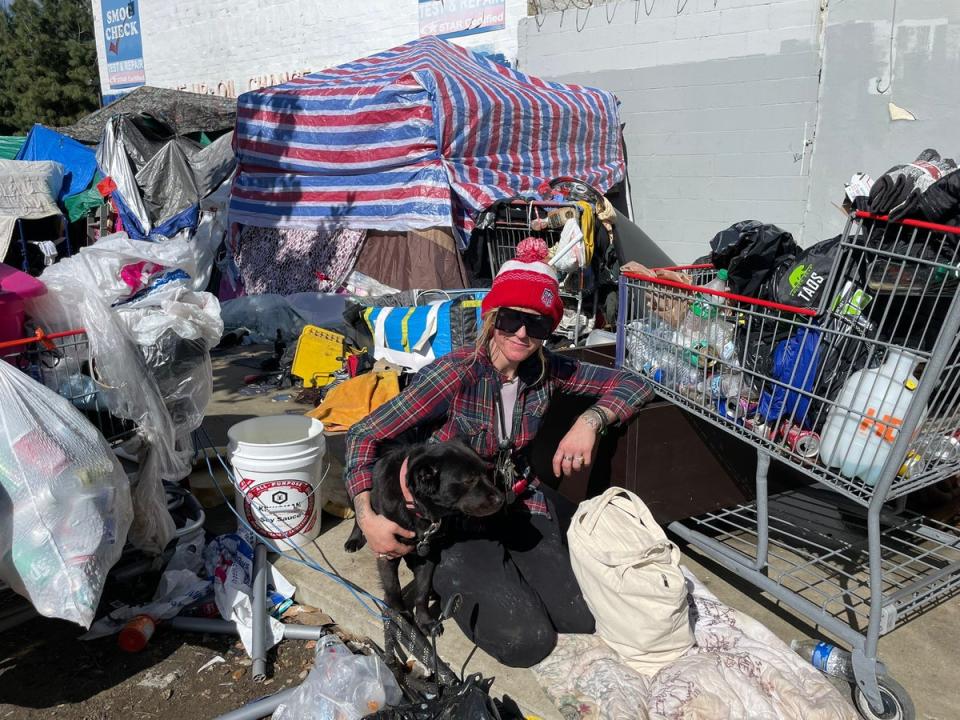
Despite the harrowing tales of the past few days, those that approach Carla seem remarkably chipper.
“I would be too, if I’d made it through that,” Carla says. “We saw one of our friends skipping down the street earlier”. It turned out it was Whitney.
‘Necessity breeds ingenuity out here’
On the corner by the Metro tracks is Ron, a 37-year-old “builder extraordinaire” who is putting the finishing touches to a temporary home. He has built several before.
The shelter, he says, is made up of a four-wheeled warehouse cart with two pallets on top. The walls are made of two discarded closet doors that Ron found outside of a paint shop. The roof is plywood and the inside is lined with carpet for insulation, with an area big enough to lie down. The structure is waterproofed with plastic sheeting.
Ron says he worked on his shelter for three or four days, including during the worst of storm, and slept inside, staying completely dry.
“This [shelter] was just out of the blue. I didn’t intend on making it. I just knew how to,” he says.
“It was actually pretty warm, it insulates and it’s small inside, it’s not meant for having a party in. But you can have guests, I actually had three people staying in there yesterday.”
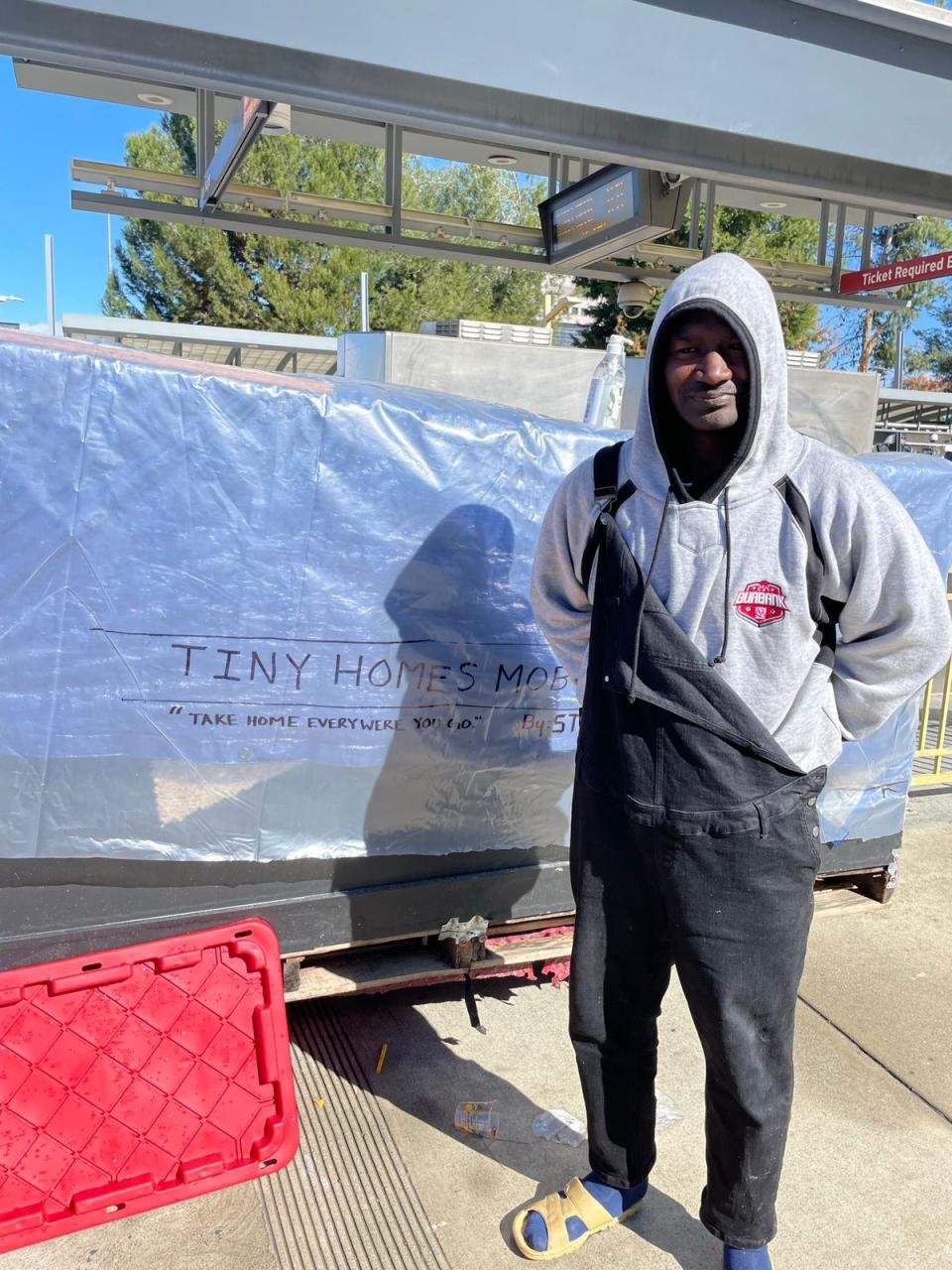
Ron has been on the streets for 10 years. “It’s been fun, it’s been not fun, it’s been very eventful every day. I’ve learned a lot and met a lot of people,” he says.
“There’s ups and there’s downs, just like anything in life. The only thing I don’t miss is paying rent.” On the side of his DIY mobile shelter he has written the slogan: “Take home everywhere you go.”
Organisers say it is time for officials to listen to those actually experiencing the conditions out on the streets, and work with them on collaborative solutions, instead of demonising them.
“People here can lay out an emergency preparedness plan, they have so many skills, they know a lot that the rest of us wouldn’t have to think about,” Carla says.
“They have so much to offer, so why aren’t we learning what the people who have no resources are doing?”
In the days before the latest storm hit last weekend, the city’s mayor, Karen Bass, and the Los Angeles Homeless Services Association (LAHSA), announced plans for “augmented winter shelter operations” to help the homeless.
Four additional locations were allocated across the city - Mid Valley Senior Citizen Center, Lincoln Heights Senior Center, the South LA Sports Activity Center, and the Oakwood Recreation Center in Venice. These provided a total of 291 extra beds.
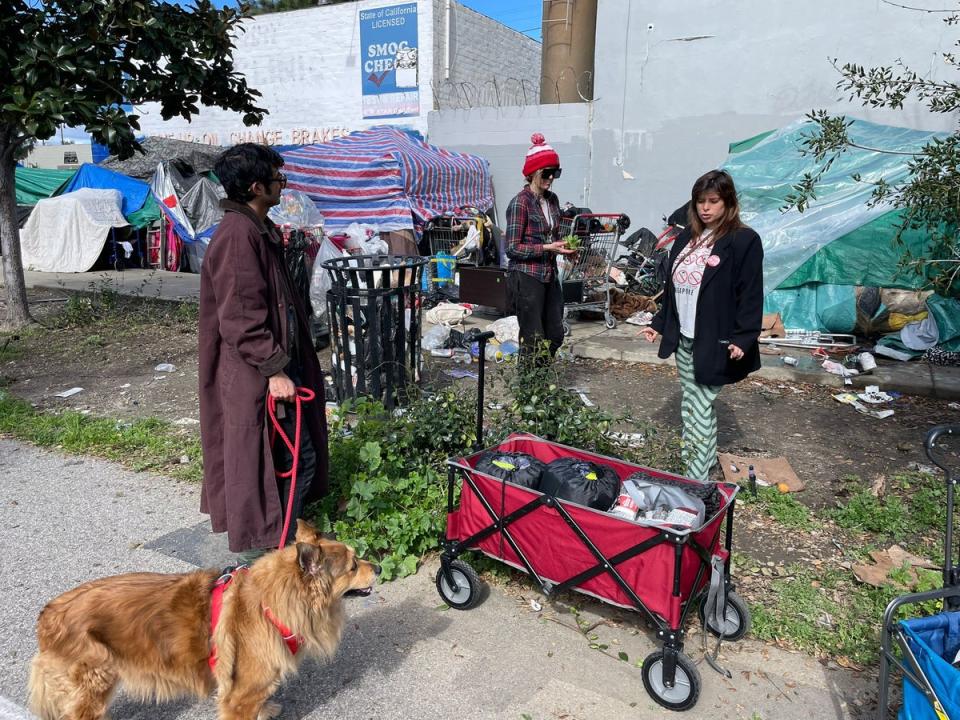
On Wednesday, the mayor’s office said that LAHSA had “activated” six additional shelters for people experiencing homelessness “in addition to the seven previously established winter shelters”. An exact number of additional beds was not given.
But for many in the homeless community, the idea of competing with others for such limited space was heartbreaking. One individual, Carla said, had told her: “I don’t have a chance and honestly getting my hopes up that way would kill me.”
LAHSA also partnered with 211 LA – an organisation that provides health, human, and social services in Los Angeles County. Individuals could call the service for help with access to a temporary shelter or to organise transportation to them during the storms.
But getting hold of someone was almost impossible, according to Carla.
“I can say from our experience of being we never talked to an actual person, we were never able to get anyone inside. We tried for hours and hours each day,” she said.
Fellow organiser Paisley, 31, who joins Carla on her route, shares the sentiment. Like Carla, he lives in an RV which he offered to his friends during the storm.
“I have tarps I was able to use to reinforce, so my RV didn’t leak which meant that it was a safe haven,” he says.
“And since I also have the privilege of having a family who have a traditional house, I actually opened my RV up to a friend who lived on the street so she was able to seek shelter and I was able to be in a house for the weekend.
“I was watching the news, [where they were] talking about ‘people can call 211 if they want to get shelter’ and, like, that wasn’t really a viable option in my experience.
“Friends that I know who were trying to access that shelter was put on hold.”
In a statement share from 211 LA, shared with The Independent by the LAHSA, a spokesperson said: “LAHSA worked closely with the City and County of Los Angeles and 211 to bring approximately 1,000 people experiencing homelessness inside during the recent storms through the Augmented Winter Shelter Program.
“The temporary shelter sites activated during the storm were consistently at or near 100% capacity, and the regular Seasonal Winter Shelter sites continued to operate at capacity as well. Motel vouchers were also fully utilized.
“During the most recent activation, 211 experienced high call volumes that led to notable wait times. LAHSA plans to work with City and County partners as well as 211 LA, the organization that operates the 211 line, to identify options for addressing this capacity issue during future activations of the Augmented Winter Shelter Program.”
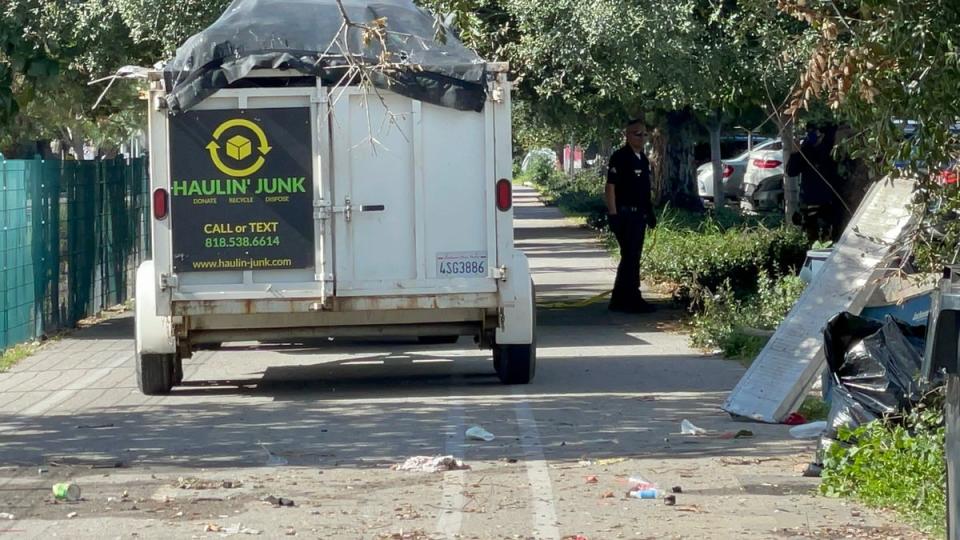
A separate statement from the Mayor’s Office added: “During the storm, the Mayor’s Office provided direct outreach to unhoused Angelenos to bring them inside into augmented winter shelters.
“Hundreds of unhoused Angelenos were able to come off the street. We have changed the way the City approaches emergency shelters – for Angelenos staying in these shelters, service providers performed assessments and are leading ongoing efforts to connect everyone who came inside with ongoing services and interim housing options.”
The statement continued: “There are concerns with certain functions of 211 and the Mayor’s Office, though not overseeing 211, will continue to work with LAHSA, the County and 211 to ensure that 211 is able to perform life-saving services during significant weather events.
According to the unhoused organisers, the City’s Care+, an ongoing program that conducts “citywide encampment clean-ups” was put on hold to allow those on the streets and affected by the rain a “moment” to recover.
However, on Friday morning members of the LAPD and sanitation workers removed Whitney’s encampment during an unannounced sweep. It was not clear who authorised the removals.
“I understand that they do the best they can with the resources that they have, but it’s like everybody wants to help the homeless or are doing so much except for asking the homeless what they need,” Whitney said, the day before her camp was trashed.
‘How did you do in the rain?’
It would not be difficult for the city to provide real assistance to the homeless community during storms, Whitney says.
“A lot of times people just end up throwing their blankets and stuff away which is sad because if there was somewhere that would allow people to come wash their things after a rain, if they just even had like a washing machine that they issued just for homeless use. It would really help a lot,” she said.
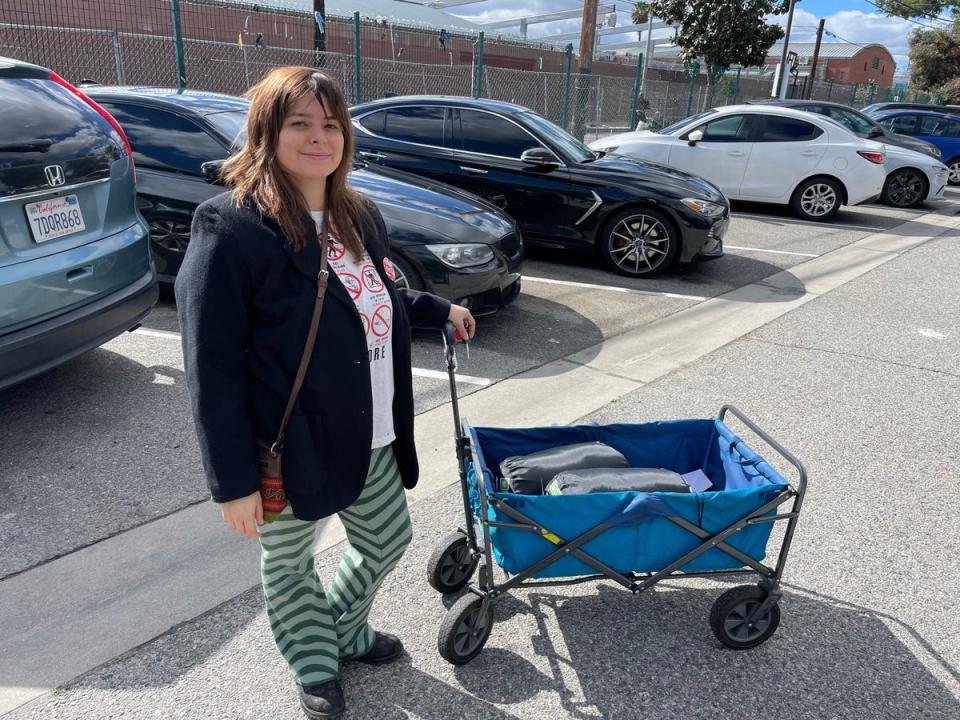
“[Items such as] blankets, and clothes and stuff like that. A lot of times we don’t even need to wash them, [just] to dry them out. You don’t want them all over the place [in your camp] because it just attracts more negative attention.”
Whitney says she has all but lost faith in the various programmes set up by the city to help the homeless.
Just then Jelly, the friend who stayed in Paisley’s RV during the storm, arrives in clear distress. When she returned to her tent after the rain, all her belongings were gone, Carla says.
“Let me know if there’s anything I can do for her,” Whitney says.
Carla and Paisley leave to go on a supply run as they have handed out nearly everything in their trolley. But they promise Whitney they will be back tomorrow.
As they wheel the trolley off, another man pulls up on a bike. “Do you have sleeping bags, I got rained out yesterday,” he says. The man takes a bag and a hygiene kit too before turning to cycle off – “y’all have a blessed day”.
“How did you do in the rain?” Carla asks him.
“I didn’t die,” he responds with a smile.


